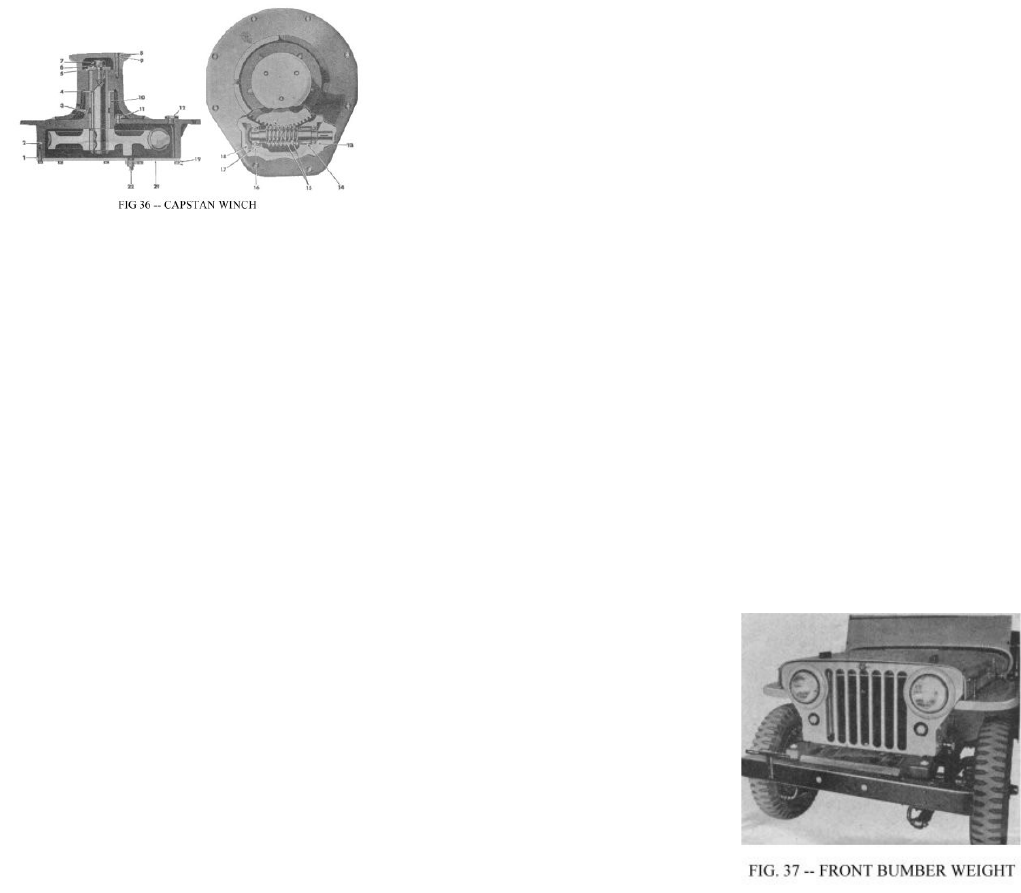
Also select the correct upper side rail (a rod approximately 30” long with one end curved) which will assemble with the curved
end next to the windshield with the curve extending up and out and with the welded eye extending in.
After selecting the correct parts install the clamp bracket, with the stud extending in and place the eye in the curved end of the
side rail over the stud on the inside of the clamp bracket. Tighten the stud nut with the clamp bracket positioned so the side rail
is level with the top of the windshield. Attach the rear end of the side rail to the eye on the top bow with the bolt lockwasher
and nut provided. Make the same assembly on the opposite side.
Next install the attaching side curtains which carry the door latches. The right and left sides may be easily selected as the lap of
the seam goes inside. Place the upper end of the rod in the curtain through the eye mounted on the side rail and attach the lower
end at the holes provided in the body. Place the bolt heads on top.
Place the top deck covering over the top bow and attach the front end on the fasteners across the top of the windshield. Fasten
the covering to the top bow with the two outer flaps. Hook one end of the centre supporting brace in the eye at the top centre of
the windshield frame and make the covering taut by hooking the rear end in the top bow eye. Fasten the centre top attaching
flap over the rear end of the supporting brace.
Snap the door jambs, which are part of the top covering, around the side rails at the top of the door openings.
Install the doors and attach the front sides to the body and windshield supports. It is necessary to open the windshield to button
the upper fasteners.
Attach the rear curtain, pulling the holding straps at the bottom taut only.
REAR ENCLOSURE
Assemble the centre section of the rear top bow between the side sections and install the assembly in the body sockets. Place
the top over the bow and fasten the front end to the rear of the front top.
The side curtains are made for the right and left sides, but when correctly installed the straps are at the bottom and on the
inside and the cutout corners are placed at the upper rear. Install both the side and rear curtains. Attach and pull down the
straps taut only.
1. Cover Plate Gasket
2. Gear Box
3. Capstan Shaft Grease Fitting
4. Capstan Shaft Thrust Washer
5. Capstan Shaft Retaining Screw
6. Capstan Shaft Screw Lockwasher
7. Capstan Shaft Screw
8. Cover Screw
9. Cover Screw Lockwasher
10. Capstan Shaft Bushing (Upper)
11. Capstan Shaft Bushing (Lower)
12. Filler Plug
13. Worm Shaft Oil Seal
14. Worm Shaft Needle Bearing
15. Worm and Gear Set
16. Worm Shaft Ball Bearing
17. Bearing Retainer Cap Gasket
18. Bearing Retainer Cap
19. Gear Box Cover Plate Screw
20. Gear Box Cover Pate Screw Lockwasher
21. Cover Plate
22. Drain Plug
CAPSTAN WINCH
The capstan winch is designed for 5000 lb. Pull, using either ¾” or 1” manila rope. The worm gears have a ratio of 75 to 1
which provides a rope speed of 19 feet per minute with an engine speed of 1200 rpm. A shift lever is mounted on the assembly
for engagement control.
Engage the drive with the engine idling only and without load: limit the engine speed to 1200 rpm.
Lubrication is important because the parts must withstand high pressures when operating at maximum pull. Filler and drain
plugs are provided in the gear housing with an oil level stick on the filler plug. The oil capacity is one quart of SAE 90 gear oil
in Summer and SAE 80 in Winter. Change the oil twice each year – in Fall and Spring.
Hydraulic fitting No. 3, Fig. 36, is provided to lubricate the capstan spindle, the position of which is indicated by the arrow
cast on the gear box. To lubricate the spindle, align the opening in the capstan with arrow. Use chassis lubricant to lubricate the
spindle, also lubricate the rope roller at each end and the shift rail and the drive shaft bushing in the winch drive support
bracket mounted on the front of the engine. Use an oil can to lubricate the winch drive universal joints.
A cotter pin is used to pin the winch drive shaft to the universal joint at the engine end and acts as a shear pin to prevent
overloading. Should this pin shear off, be sure to replace it with a cotter pin of the same size. Do not replace it with a solid pin
or drill the hole oversize for a larger pin.
FRONT BUMPER WEIGHT
The best performance of a four-wheel drive vehicle is achieved when the load is equally
distributed for traction on the front and rear wheels. This equal distribution is disturbed
when the vehicle is used for draw bar work because the load on the rear wheels is
increased and that on the front wheels decreased. The addition of a 265-pound front
bumper weight equalizes this load.
When the load is equalized the front and rear axles do approximately the same work
which results in an equal and prolonged life of these parts and more satisfactory vehicle
performance.
The bumper weight Fig. 37 is held in place by four bolts and is provided with hand holes
for lifting. Do not add sand bags or other weights in the vehicle. When driving over
rough terrain, with the bumper weight in place, the driver should exercise due care.


















